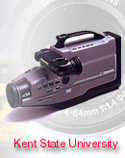

MIDTERM EXAM STUDY GUIDE
PARTS OF THE CAMERA
Where are they? What do they do? How, when and why do you use them?
| battery | battery eject button | power switch | |
| videocassette (VHS) | stop/eject button | record tab | |
| electronic viewfinder | vision adjustment control | display button | |
| date/time display | battery remaining display | tape remaining | |
| record/pause switch | record switch cover | VCR/camera switch | |
| lens cap | hand strap | standby mode | |
| wind buffer switch | VCR controls for playback | zoom control | |
| high speed shutter | auto/manual operations | fade | |
| backlight | focus (auto, manual, macro) | lens focus dial | |
| tally light | built-in microphone | external mic jack |
SHOT COMPOSITION
What do these terms mean? How and why do we use these to achieve pictures that look professional and communicate meaning?
| shot sizes: WS, LS, MS, CU | camera angles: high, low, normal | |
| center of interest | rule of thirds | |
| head room and look space | leading lines | |
| depth (illusion of depth) | frame-within-a-frame | |
| movement in the frame | camera moves: pan, tilt, zoom | |
| color | background objects |
When and why do we shoot with a tripod? How can we keep images steady without one?
What are some differences between film and videotape?
What are some things we can do to properly care for videotapes? for videotape recorders, including the record mechanisms inside camcorders?
What are some good reasons for using camera movement?
Why do we avoid the autofocus setting?
What are the proper steps to manually focus a camera with a zoom lens?
AUDIO
Why does a videographer need to know about audio? What standard practices do videographers follow to get good audio?
styles of microphones: built-in (on-board), hand-held, lapel or lavaliere, wireless, shotgun. What are the advantages and disadvantages of each?
pickup patterns: omnidirectional, unidirectional, bidirectional, cardioid
What are some good rules for positioning and talking into mics?
What factors affect audio on location? What can you do to improve location audio?
IN-CAMERA EDITING
What do these terms mean?
| snapshooting | firehosing | jump cut | |
| cutaway | insert | continuity |
Why do we edit videotape, either in the camera or in post-production?
What are some good rules to follow in order to avoid jump cuts?
Home Page | Assignments | Syllabus | Instructor | JMC Web Site